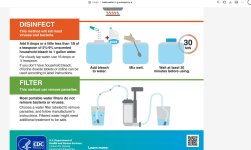bajajoaquin
Adventurer
Several years ago, there was an Expedition journal issue with the dilution for adding bleach to water to make it potable, but not so much bleach that it wasn’t.
My friend filled his 25 gal tank with questionable water and we want to make sure it’s drinkable.
If you look online, you mostly get bleach ratios for winterizing or sanitizing tanks. Anyone know the proper bleach to water ratio?
My friend filled his 25 gal tank with questionable water and we want to make sure it’s drinkable.
If you look online, you mostly get bleach ratios for winterizing or sanitizing tanks. Anyone know the proper bleach to water ratio?




